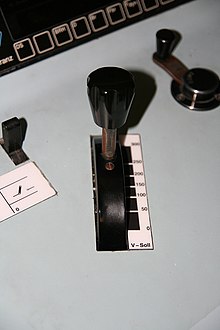Linienzugbeeinflussung
[1] Driving cars mostly have to replace classical control logic to ETCS Onboard Units (OBU) with common Driver Machine Interface (DMI).The LZB cab signalling system was first demonstrated in 1965, enabling daily trains at the International Transport Exhibition in Munich to run at 200 km/h.[4] The control centre computer receives information about occupied blocks from track circuits or axle counters and locked routes from interlockings.It is programmed with the track configuration including the location of points, turnouts, gradients, and curve speed limits.The control centre communicates with the train using two conductor cables that run between the tracks and are crossed every 100 m. The control centre sends data packets, known as telegrams, to the vehicle which give it its movement authority (how far it can proceed and at what speed) and the vehicle sends back data packets indicating its configuration, braking capabilities, speed, and position.If the driver exceeds the permitted speed plus a margin LZB will activate the buzzer and an overspeed light.However, even with strong brakes and the same deceleration, a train travelling 200 km/h (120 mph) would require 1,543 m (5,062 ft) to stop, exceeding the signalling distance.In addition, it wouldn't solve the other problem with high-speed operation, the difficulty of seeing signals as a train rushes past, especially in marginal conditions such as rain, snow, and fog.The first prototype system was developed by German Federal Railways in conjunction with Siemens and tested in 1963.It was installed in Class 103 locomotives and presented in 1965 with 200 km/h (120 mph) runs on trains to the International Exhibition in Munich.From this Siemens developed the LZB 100 system and introduced it on the Munich-Augsburg-Donauwörth and Hanover-Celle-Uelzen lines, all in Class 103 locomotives.However, as the 1970s progressed Standard Elektrik Lorenz (SEL) developed the computer-based LZB L72 central controllers and equipped other lines with them.Siemens continued to develop the system, with "Computer Integrated Railroading", or "CIR ELKE", lineside equipment in 1999.One disadvantage of very long loops is that any break in the cable will disable LZB transmission for the entire section, up to 12.7 km (7.9 mi).[5] All 3 computers receive and process inputs and interchange their outputs and important intermediate results.The computers are programmed with fixed information from the route such as speed limits, gradients, and the location of block boundaries, switches, and signals.Finally, the route centre's computers communicates with controlled trains via the cable loops previously described.Thus a trains address will gradually increase or decrease, depending on its direction, as it travels along the track.The main task of LZB is signalling to the train the speed and distance it is allowed to travel.The display will normally give the distance and target speed at the end of the controlled section, which will depend on the signal at that point.As a train approaches a crossover to a normally opposite direction track the display will flash the "E/40" light.The driver must slow the train to no more than 85 km/h (53 mph) or lower; the exact speed depends on the backup signalling system in place.It uses the same physical interface and packets as standard LZB but upgrades its software, adding capabilities and modifying some procedures.The name is an abbreviation of the English/German project title Computer Integrated Railroading - Erhöhung der Leistungsfähigkeit im Kernnetz der Eisenbahn (Computer Integrated Railroading - Increase Capacity in the Core Railway Network).CIR-ELKE includes the following improvements: The original LZB system was designed for permitted speeds up to 280 km/h (170 mph) and gradients up to 1.25%.With the exception of line 6, the entire Vienna U-Bahn is equipped with LZB since it was first built and includes the capability of automatic driving with the operator monitoring the train.In the evenings from 9:00 p.m. until end of service and on Sundays the operators drive the trains manually according to the stationary signals in order to remain in practice.The Docklands Light Railway in east London uses the SelTrac technology which was derived from LZB to run automated trains.











cab signallingtrain protection systemGermanAustrian railwayrapid transitEuropean Train Control SystemEuropean Union Agency for Railwayssignalbraking distancetrack circuitsaxle countersAutomatic Train ProtectionAutomatic Train OperationIndusitrack brakesGerman Federal RailwaysSiemensStandard Elektrik LorenzMadridCordobaSevilleAustrian railwaysWestbahnForchheim–Bamberg lineMunich–Augsburg lineClass 103Bremen–Hamburg lineHamm–Gütersloh lineDeutschen BundesbahnFulda–WürzburgMannheim–HockenheimAustrian Federal RailwaysHanover–Würzburg high-speed railwayMannheim–Stuttgart high-speed railwayMadrid-Sevilla high-speed rail lineWien–SalzburgCercaniasHanover–Berlin high-speed railwayNuremberg–Würzburg railwayOffenburg–Basel lineAchernCologne–Frankfurt high-speed rail lineCologne–Düren(–Aachen)Hamburg–Berlin lineMunich S-BahnBerlin–HalleLeipzigNuremberg–Munich high-speed railwayphase angle8085 microprocessorsassembly languageantennasamplifiersdemodulatorEmergency brakeSerial interfacecruise controlFrequency-shift keyingCyclic redundancy checkgradientsEddy current brakeJühndeHanover-WürzburgOschatzLeipzig-DresdenBienenbüttelHamburg-HanoverHanover-Berlin high-speed rail lineDB CargoDB Passenger TransportDeutsche BahnAugsburgDinkelscherbenBerlinWittenbergeHagenow LandRothenburgsortHamburgBremenDortmundHamm (Westf)BielefeldFrankfurt am MainGelnhausenHannoverStadthagenMindenUelzenLüneburgGöttingenKassel-WilhelmshöheWürzburgKarlsruheOffenburgKenzingenLeutersbergWeil am RheinBasel Bad. Bf.AachenDüsseldorfDuisburgDüsseldorf main stationTroisdorfMontabaurLimburg a.d. LahnWurzenDresdenLengerich (Westf)Münster (Westf)LehrteStendalBerlin-SpandauMannheimVaihingen an der EnzStuttgartMünchenDonauwörthAugsburg main stationNürnbergAllersbergKindingIngolstadtNeustadt an der AischOsnabrückPaderbornLippstadt